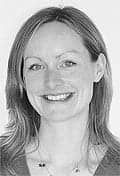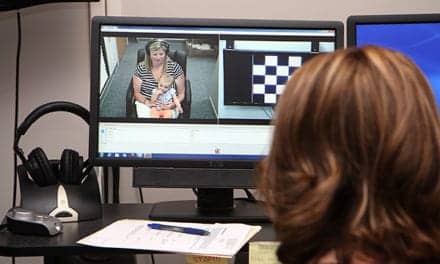The view is taken that a condition, termed auditory deprivation by Silman, Gelfand & Silveman1, occurs when loss of acoustic stimulation desensitizes auditory processing. Depriving the brain of adequate input for an extended time may cause the auditory system to reduce its word processing ability. While the brain still receives sound, it can grow less and less responsive to the filtered components, and a gradual decline in auditory processing may follow. If the brain becomes accustomed to disregarding signals that lack recognizable identity, then auditory processing may continue to diminish while the brain is still receiving signals in response to sounds.
Sound serves to stimulate and reinforce auditory processing. Unstimulated function may cause this processing to fall into disuse and atrophy.8,9 For example, reduced recognition ability appears to occur more often with moderate-to-severe SNHL than with mild-to-moderate SNHL.10,11 The longer hearing loss deprives the brain of stimulation, the more likely word recognition will continue to decline from lack of use. This disuse pattern is consistent with the law of atrophy which states that things isolated move toward deterioration; skill that is not maintained by active use declines. When a processing activity in an area of the brain no longer receives sufficient stimulation, its ability to function diminishes.
Chronic SNHL decreases auditory processing by restricting how much stimulation reaches the brain. Inadequate stimulation inhibits the use of auditory language skills and, in turn, accelerates a decline in speech perception. At this point, the dysfunction reflects two factors: the loss of acoustic cues filtered by hearing loss, and a decline in the ability to use available auditory information.
Pilot Study
To look further into the above ideas, the Speech-in-Noise (SIN) test was administered to 55 adults with moderate SNHL. Participants included 31 new hearing instrument wearers and 24 experienced wearers. Subjects ranged in age from 43-86 years old with a mean age of 71. All subjects had moderate hearing losses with similar audiograms of flat to gently sloping configurations, and were fit with analog, binaural hearing instruments.
The goal was to find the highest score (at 70 dB HL or 40 dB HL) that each person could achieve either with or without his/her hearing instruments. Each sentence of the SIN contains five test words worth four points each, and each test block equals 100 points. From the results, the subjects were placed into two groups: 1) The high recognition group consisted of scores at or above 200 points; 2) The low recognition group contained scores below 200 points (i.e., a person who scores below 200 points is more likely to have trouble interpreting speech than a person who scores above 200).

These results support the observation that some people use residual hearing more effectively or retain perceptual skills longer than others. In either case, the wide differences in scores suggest that an underlying functional component is influencing speech perception.
The next step was to compare the highest SIN scores of new hearing instrument wearers with experienced wearers. All experienced wearers had used hearing instruments for at least one year. Fig. 2 shows that experienced wearers in the high recognition group scored a mean of 226 compared with 238 by new wearers. In the low recognition group, experienced wearers scored a mean of 113 compared with 147 by the new wearers. In each case, the experienced wearers’ best scores were lower on the SIN test than new instrument wearers, even though the ages and demographics of the two groups were roughly the same.

The second point derived from these data concerns the great differences observed in each person’s ability to use residual hearing effectively. It’s possible that the wide variations may reflect some characteristic differences in the individual’s auditory perception or organization. If this is true, it’s also possible that a procedure might be developed to stimulate adaptation—one that enhances the ability of the auditory system to adapt to the acoustic variations produced with hearing instruments. If successful, this procedure would increase the effectiveness with which a person uses residual hearing when utilizing amplification.
An investigation of sound conditioning principles led to the development of an experimental procedure involving the exposure of patients to controlled levels of distorted stimulation created by complex sounds. The goal was to investigate whether overloading the hearing system with input can stimulate the adaptive process to reorganize and modify its response patterns to speech in noise. The study sought to answer the question: Can exposure to progressive degrees of distortion improve a person’s ability to interpret speech? A simplified example of this might be to consider people who become accustomed to listening to a CB radio, and are undisturbed by its low sound quality, while inexperienced CB listeners hear, for the most part, unintelligible garbled speech.

The goal was to study whether the experimental procedure (described below) leads to a measurable difference in the SIN scores immediately after the sixth exposure. Each subject served as his or her own control. It was also important to differentiate acclimatization to hearing instruments from effects of repeated exposure to degraded speech. Therefore, the aided pre-treatment scores on the SIN test for the experimental group served as a second control. All 10 people had worn hearing instruments for at least one full year, typically for many years. If a difference in SIN scores occurred in this group, the post-treatment change is not attributable to acclimatization.
The experimental procedure uses a sound chamber that contains multiple speakers. This speaker system overlaps acoustic energy from different sources, presenting each sound source from a separate location. Overlapping the sounds in a confined area creates acoustic distortion. Spatial placement controls the amount of distortion that occurs. Speech and other signals are placed closely together in a listening field with just enough distance apart to remain perceptually separate. Sounds intermix, but the spatial distance between them preserves the identity of the individual sound sources. Adding more sounds from other locations increases acoustic distortion by decreasing the space between each sound source. This allows for more intense overlapping of sound.
Each sound exposure in the pilot study involved a mixture of signals from various sources, gradually introduced into the listener’s background. The mixture of sound consisted of intelligible speech spoken by male and female speakers, along with music and environmental sound sources. The more sounds that competed with the speech, the more challenging it was for the subject’s auditory system to compensate. Each sound exposure was progressively more challenging than the last.
Results
Fig. 3a shows that new instrument wearers increased their mean SIN test scores by 14% wearing hearing instruments. Immediately after completing the sound exposure procedure, scores increased an additional 86% above the hearing instrument level. Experienced wearers had similar results. Scores increased by a mean of 19% wearing hearing instruments. Post treatment scores then increased an additional 137% above the hearing instrument level.
Fig. 3b shows a similar trend at the 40 dB level. New wearers improved their mean score from a baseline of 10 to 77 total points wearing hearing instruments. Mean scores then increased an additional 140% above the hearing instrument level following the experimental procedure. Experienced wearers improved their mean score from a baseline of 0 to 23 total points wearing hearing instruments. Mean scores then increased an additional 200% above the hearing instrument level following the procedure. At both levels, experienced wearers showed a higher increase in their post-treatment scores on the SIN test than new wearers.
Discussion
While the above is a pilot study only, admittedly small in the number of subjects and not scientifically rigorous in set-up (e.g., no separate control group, etc.), the results are nonetheless intriguing. A comparison of the aided pre-and post-treatment scores on the SIN test showed that each group produced significant, if not dramatic, differences in aided SIN scores. Experienced wearers who had acclimated to hearing instruments produced a larger difference in SIN scores than new wearers.
The study was intended to answer the question: Can exposure to progressive degrees of distortion stimulate the auditory system to adapt by increasing its ability to interpret speech? Results suggest an affirmative answer. Certain findings seem evident. External sound can stimulate and enhance the adaptive response of the auditory system. Increased scores on the SIN test following treatment strongly suggest that this procedure can lead to enhanced auditory processing abilities.
While results varied, all subjects increased their scores above the hearing instrument level after the experimental procedure. This pattern of response supports the view that a dysfunction (whatever that might be) is responsible for a considerable portion of poor word recognition. It also appears that the functional element responds favorably to the sound-conditioning procedure described. More study in this area is being pursued by the author in hopes that a detailed description of the sound-conditioning mechanism and how this mechanism influences hearing performance is revealed.
References
- Silman S, Gelfand S & Silveman C: Effects of monaural versus binaural aids. JASA 1984; 76 (11): 1357-1362.
- Gelfand S, Silman S & Ross L: Long-term effects of monaural, binaural and no amplification in subjects with bilateral hearing loss. Scand Audiol 1987; (16): 201-207.
- Silveman C: Auditory deprivation. Hear Instru 1989; 40 (9): 26-32.
- Stubblefield J & Nye C: Aided and unaided time-related differences in word discrimination. Hear Instru 1989; 40 (9) 38-43, 78.
- Emmer M: The effect of lack of amplification on speech recognition in the unaided ear. Hear Instru. 1990; 41 (9):16.
- Silveman C & Silman S: Apparent auditory deprivation from monaural amplification and recovery with binaural amplification. JAAA 1990; (1): 175-180.
- Gelfand S: Long-term recovery and no recovery from auditory deprivation effect with binaural amplification: Six cases. JAAA 1995; (6): 141-149.
- Aoki C & Siekevitz P: Plasticity in brain development. Scientific American 1988; 259 (6): 56-64.
- Cowan, WM, Fawcett, JW, O’Leary, DM & Stanfield, B: (1984). Regressive events in neurogenesis Science 225 (2668), 1258-1265.
- Emmer MB: Review of Late-onset auditory deprivation and clinical implications. Hear Jour 1999; 52 (11): 26-32.
- Hurley RM: Is the unaided ear effect independent of auditory aging? JAAA 1998; 9 (1), 20-24.
John Isenhath, PhD, is a private practice audiologist who has three offices located in Staunton, Charlottesville and Harrisonburg, VA.
Correspondence can be addressed to HR or John Isenhath, PhD, Advanced Hearing Care Inc., 1020 N. Augusta St., Staunton, VA 24401; email: [email protected].





